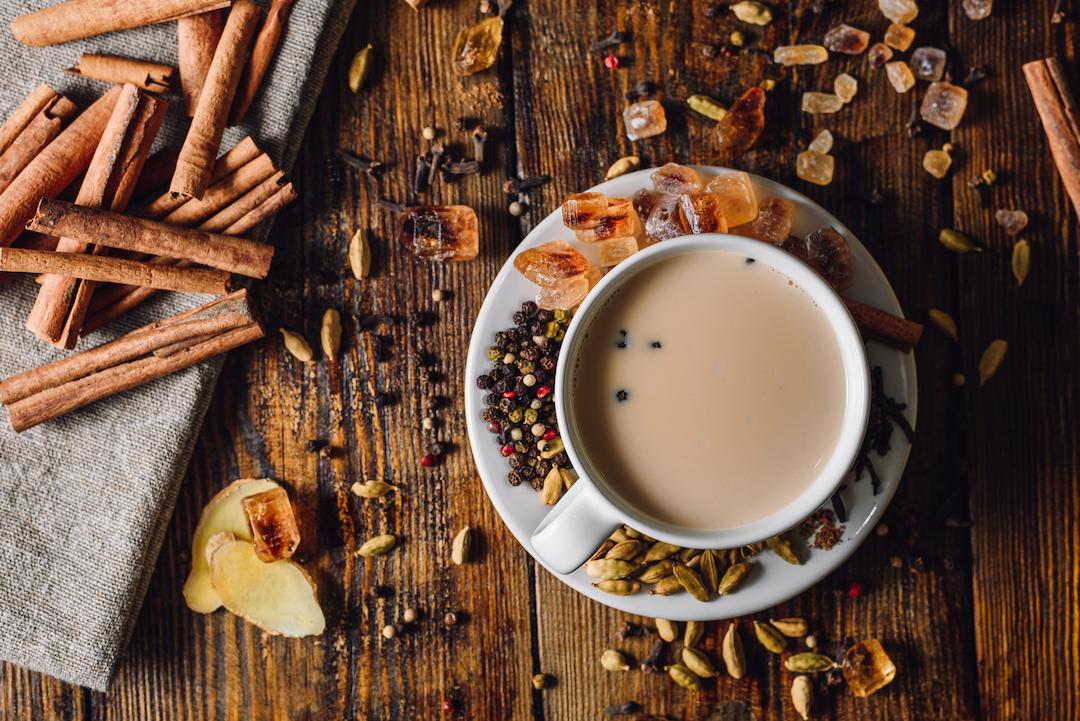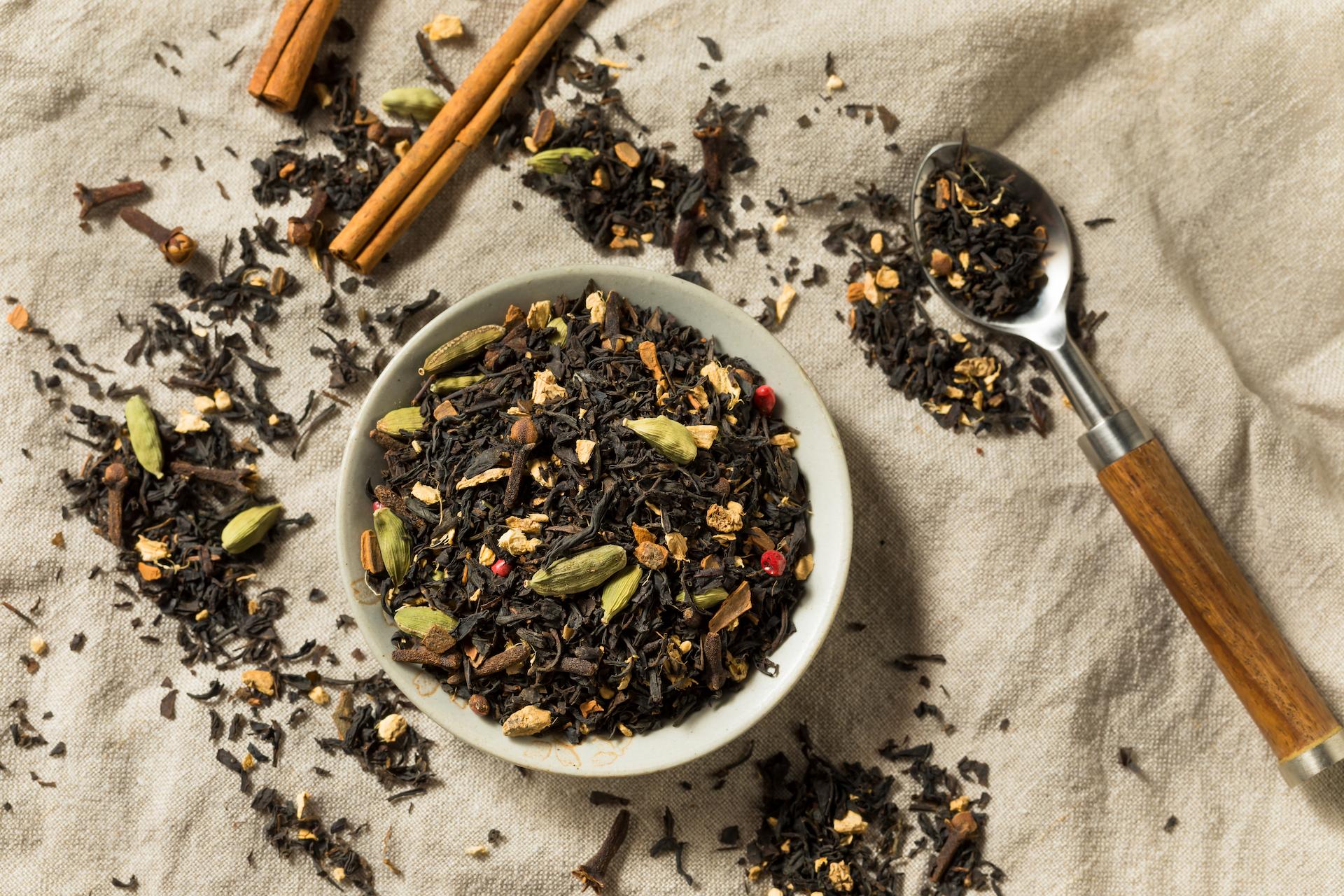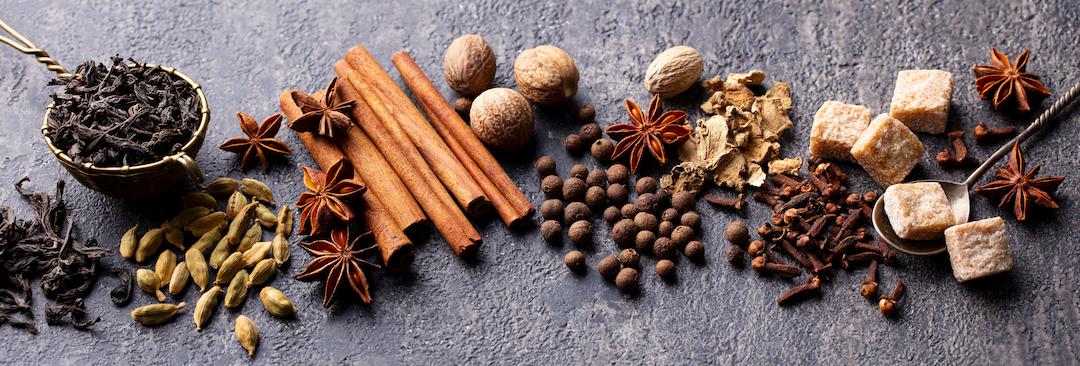Your Ultimate Guide To Chai Tea: Masala Chai
Posted by Elise Goldsworthy BHSc (Nutrition Science) on 7th Apr 2022
Chai. Five Spices. One Tea. How can so much deliciousness come from just a few ingredients steeped in hot water? Therein lies the art of a perfect cup of tea. And while chai is no ordinary tea, it’s a fine example of how different elements alchemise to produce something more than just the sum of its parts.
Here we have, the classic masala chai.
The word ‘chai’ conjures up lovely feelings of warmth and nourishment. This warming, milky, spiced tea is popular in most cafés, teahouses and trendy restaurants around the world. You may even have a stash of chai in your own home tea collection.
You already love chai, but do you know where it comes from? Why has it gained so much popularity? Importantly, how can you make it for yourself? Chai is a symphony of spice that’s as exciting as it is delicious. Here’s your ultimate guide to chai tea including how to brew chai like an Indian tea master!

The History of Chai Tea
Chai tea, traditionally known as masala chai, is a spiced tea originating from India. Chai is the Hindi word for tea and the word has older origins in Mandarin, derived from the word ch’a. The popularity of chai tea or masala chai arose following the influence of the British East India Company. This was in response to the increasing influence of Chinese teas in India. The British sought to promote local tea varieties, like Darjeeling and Assam, to compete with those from China.
The history of masala chai is rather ambiguous. Some evidence points towards that this strongly spiced tea was created to rival coffee, which was the beverage of choice at the time. Tea itself has a range of health benefits, yet the spices give it an extra therapeutic edge. Adding potent spices to a milky tea was one way to ensure the locals and visitors had something to enjoy that was just as satisfying and robust as coffee.
One influencing body was the Indian Tea Association, who were instrumental in campaigning factory workers to have ‘tea breaks’. Employees would meet for tea with friends and families during their breaks, which helped weave regular tea consumption into the daily lives of Indian society. This promoted regular tea drinking with a tea that reflected the local Indian palate. And thus masala chai was born.
Flavour & Aroma
Each element within a chai combines beautifully to give a fragrant and enjoyable cup of tea. Heady cardamom and clove, warming cinnamon and ginger, piqued with black pepper. These spices are layered over a robust base of black tea. The usual black teas that provide the foundation for a chai include Assam or Darjeeling teas. Ceylon tea is also a commonly used substitute in a masala chai. Then the entire brew is rounded out perfectly with milk. Full cream milk calms the intensity provided by both the spices and the tea itself. Chai is a tea for the senses. It’s a pleasurable warm cup, with a hint of caffeine for liveliness. This brew is a delicious break from a standard cup of tea.
As teamakers branch out and become increasingly brave with their creations, it’s not uncommon to see different chai blends using varied tea bases, extra spices and other exciting flavours. A relaxing ‘zen’ style chai, the Yogi Chai blend has hawthorn petals to promote relaxation. For a sweet and romantic take on chai, Punjabi Chai is a wonderful blend. Filled with rose petals, citrus and vanilla, it’s a true sensory delight. Of course if you want a classic and pungent chai, you can’t go past the intensity of a Black Spiced Chai. To make it completely your own, you can also experiment with different milks, with coconut, almond or soy chai teas among the most popular variations.

Chai Tea vs. Chai Latte
For most people, their first introduction to chai isn’t at all as masala chai, but with a Westernised chai latte. What’s the difference? Well, it’s all about that frothy, velvety milk! A chai latte has all the hallmarks of a masala chai, as it’s made with the same chai concentrate (base). Then, instead of topping it off with a dash of milk, as you’d expect with a black tea, you add frothed warmed milk.
The lovely thing about a chai latte is that it mellows the more herbal notes that spices like cardamom and clove tend to impart. What you get is a creamy, rounded and smooth drink that warms you from the inside out. If you find classic masala chai too strong, I’d say try a chai latte and see if that’s more your thing.
A sure-fire way to get a balanced chai latte with literally no fuss, is to use a chai latte powder. Expertly made and using just the right mix of spice, black tea and sweetener, these ready-made powders have been thoughtfully done for you.
Once you’re in chai latte-land, and you’re keen on making them at home, you can get adventurous with your tea base options. For a lovely caffeine-free option, try a rooibos chai on for size. This is a lovely red-velvet style chai that has immune-boosting qualities as well.
How To Make Chai Tea from Scratch
Yes, you can make chai tea using a tea bag. And of course, by all means enjoy the chai powders for a latte. But if you really want to make the most authentic, fragrant and delicious chai like a true Indian tea master, then making it from scratch is the only way. The great news is that to make a proper masala chai, it’s not that difficult. You’ve likely got the spices hidden away in the pantry already.
Preparing a tea such as chai is a ritual unto itself. Yet it’s one well worth the effort. Once you have the spices, known as a karha at the ready, you’re on your way to an indulgent brew. There’s something special about collecting fresh cardamom pods, cinnamon sticks, peppercorns, cloves and ginger that makes it feel almost medicinal. In fact these spices feature strongly in Ayurvedic medicine and convey a range of health benefits.
How To Brew The World’s Best Chai Tea (Masala Chai)
Here’s how to make an authentic masala chai from scratch. Everything is here from gathering all the ingredients, grinding and cooking the spices, steeping your tea and adding your desired sweetener. The following recipe makes enough masala chai for 4 people. Let’s get into it.

Step 1: Sort Your Ingredients
Spices
- 1 thumb-sized piece of fresh ginger, sliced
- 2 cinnamon quills
- 4 black peppercorns
- 8 cardamom pods or cardamom seeds
- 8 cloves
Tea
- 4 black Assam or Darjeeling tea bags OR 4 teaspoons of loose leaf black tea
Liquids
- 2 cups full cream milk
- 2 cups of water
Sweetener
- 4-8 teaspoons sugar to taste (optional)
Step 2: Grind Your Spices
Grinding these spices by hand will give you a genuine chai tea flavour. If you’re using cinnamon quills, it can be laborious trying to grind everything down, but aim for small chunks and it can be done. There’s a couple of options for grinding your chai blend spices:
- Place all the spices into a sealed bag and crush with a mallet
- Pulverise into rubble with a mortar and pestle
- Use a spice grinder for a perfect chai spice mix
Step 3: Simmer Your Spices
Add the ground cinnamon, ginger, cloves, peppercorns and cardamom to a pot of combined milk and water. Bring these ingredients to a rolling boil before steeping the tea.
Step 4: Steep Your Tea
Once you’re on a rolling boil, remove the pot from the stove and add the black tea bags or loose leaf tea. Cover and allow to steep for 10 minutes. This allows all the flavours from the spices and tea to infuse thoroughly.
When you’ve reached your desired strength (taste throughout the steeping time to check), then remove the tea bags.
Finally, use a mesh strainer to remove any large spices or loose leaf tea and pour the tea infusion into a cup or mug.
Step 5: Add Sweetener
Traditional masala chai teas are not sweetened. This allows the earthy and robust flavours of each spice to truly shine. However, feel free to add sugar to taste or a dash of honey if preferred.
Top Tips When Brewing Your Chai Tea
There’s some key elements to get right when making chai at home. Here’s some tips to master your chai-making so you and your friends can enjoy a traditional masala chai in no time.
- Using the best quality, filtered or spring water will produce the best tasting tea
- Loose black tea leaves will give the most health benefits and stronger flavour
- The chai base (concentrate) can be brewed and stored for later use
- Likewise for the spices, grinding them in big batches and storing them in sealed bags is a great way to save time and effort for your next brew
- Using whole milk will help the spices and tea develop their deepest flavour. However if you want to experiment, soy milk, almond milk or macadamia milk is also delicious
- Chai brewed with different tea leaves will call for different temperatures and steeping times. For example, be mindful of using lower temperatures for green or oolong varieties if your chai mix uses these as the tea base
- If you prefer a kettle, use a temperature controlled tea kettle if possible. This means you’re in total control of the brewing temperature for your tea. Also, the incorrect temperature won’t impact the final flavour of your chosen brew
- Mixing things up with your spices allows you to create something unique. Adding anise, fennel seeds or saffron can make your chai a signature all of your own. Wherever possible, source organically grown spices to ensure your tea is free from chemicals or pesticides
How To Store Chai Tea
Chai can be stored for about a year while still maintaining its freshness and vibrant flavours. Ideally, chai blends should be stored in a cool, dark place away from direct sunlight and moisture.
References
Hayat, K., Iqbal, H., Malik, U., Bilal, U., & Mushtaq, S. (2015). Tea and its consumption: benefits and risks. Critical reviews in food science and nutrition, 55(7), 939–954. https://doi.org/10.1080/10408398.2012.678949
https://pranachai.com/blogs/prana-chai-blog/is-chai-good-for-you-the-benefits-of-chai-tea
Jiang T. A. (2019). Health Benefits of Culinary Herbs and Spices. Journal of AOAC International, 102(2), 395–411. https://doi.org/10.5740/jaoacint.18-0418
Khan, N., & Mukhtar, H. (2018). Tea Polyphenols in Promotion of Human Health. Nutrients, 11(1), 39. https://doi.org/10.3390/nu11010039
Serafini, M., Del Rio, D., Yao, D. N., Bettuzzi, S., & Peluso, I. (2011). Health Benefits of Tea. In I. Benzie (Eds.) et. al., Herbal Medicine: Biomolecular and Clinical Aspects. (2nd ed.). CRC Press/Taylor & Francis.
Shang, A., Li, J., Zhou, D. D., Gan, R. Y., & Li, H. B. (2021). Molecular mechanisms underlying health benefits of tea compounds. Free radical biology & medicine, 172, 181–200. https://doi.org/10.1016/j.freeradbiomed.2021.06.006
Tang, G. Y., Meng, X., Gan, R. Y., Zhao, C. N., Liu, Q., Feng, Y. B., Li, S., Wei, X. L., Atanasov, A. G., Corke, H., & Li, H. B. (2019). Health Functions and Related Molecular Mechanisms of Tea Components: An Update Review. International journal of molecular sciences, 20(24), 6196. https://doi.org/10.3390/ijms20246196
Wikipedia Contributors. (2022, March 29). Masala chai. Retrieved from Wikipedia website: https://en.wikipedia.org/wiki/Masala_chai, viewed March 29, 2022
Wikipedia Contributors. (2022, March 29). Tea. Retrieved from Wikipedia website: https://en.wikipedia.org/wiki/Tea, viewed March 29, 2022
